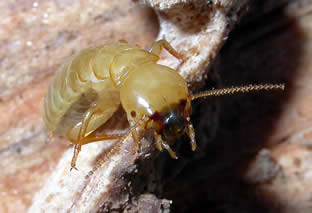

THE TERMITES (ISOPTERA) OF BRITISH COLMBIA

Termite (undetermined), photo by Dave Ingram
by
R. A. Cannings and G. G. E. Scudder
Copyright © 2005 - All rights reserved
Extracted from the forthcoming publication The Insect Families of British Columbia.
Introduction (draft only)
Termites are social insects that live in colonies where different functions are performed by separate castes; their societies are one of nature's most impressive biological organizations. Caste organization varies considerably in different kinds of termites. They may include reproductive individuals, sterile soldiers and sterile workers, but because termites are hemimetabolous, immatures also are potential contributors to the work of the colony. Unlike in Hymenoptera, non-reproductive castes of termites are both male and female. Most species also can produce male and female supplementary reproductives if the primary reproductives (queen and king) disappear, giving colonies flexibility and continuity. The efficient development of the colony is mostly regulated by chemical communication.
There are about 2000 species of termites in seven families world-wide; most are tropical. There are two main grades of termite organization, the so-called lower and higher termites. The former consist of several families, including the ones found in British Columbia, distinguished, among other things, by their possession of symbiotic intestinal flagellates that help them digest wood. The higher termites belong to the exceptionally diverse family Termitidae, which is mostly tropical and includes 75 per cent of all termite species. Instead of flagellates, they have symbiotic bacteria in the gut. This family has successfully evolved away from a direct dependence on wood for nutrition; some groups grow fungi for food.

Termite (undetermined), photo by Dave Ingram
Termites evidently evolved from a cockroach-like ancestor. The most primitive living species, Mastotermes darwiniensis Froggatt, is considered a sort of link between cockroaches and termites: it has several characteristics of the former order: the tarsi have five segments, the hindwing is broad, the wings do not break along a line of weakness at the base, and the eggs are contained in a package like a cockroach ootheca. A fossil termite closely related to Mastotermes has been found in British Columbia.
Three termite families, each containing one genus (one of these is introduced), live in British Columbia. There are only four species, but their life histories are diverse.
The termite body is small to medium-sized (except for the distended queens of some tropical species), cylindrical or rather flattened and usually weakly sclerotized and pale in colour. The head and thorax are often more heavily sclerotized and darker than the abdomen, especially in flying forms or soldiers. Mouthparts are the chewing type and the antennae are thread-like.
When present, the front and hindwings in almost all species are similar; they are membranous with few veins, but often have abundant vein-like wrinkles. The wings are held flat over the body and extend past the end of the abdomen. They are shed after the nuptial dispersal flight; they fracture near the base along a line of weakness. The legs are short, without pronounced spines, and the tarsi typically have four segments. The abdomen is broadly joined to the thorax; the cerci are usually short and the genitalia are normally reduced and hidden beneath an elongated subgenital plate.
Reproductives (kings and queens ) are fully developed sexually -- they have functional wings and compound eyes. Queens in some tropical species get very large (5-10 cm long) and may live for years, laying many thousands of eggs. Flying termites appear in large numbers at certain times of the year, mate and start new colonies. Supplementary or secondary reproductives may also occur; they are less well developed than primary ones, but may reproduce in the nest and supplement the queen in building the colony. Soldiers are sterile, wingless adults with enlarged heads and mandibles that aggressively protect colony from external hazards. In some genera, but not B.C. ones, a nasute caste has the head projected into a nozzle that sprays noxious fluids at invaders. Workers are nymphs or sterile adults; they are pale, wingless and lack compound eyes. In some primitive groups, such as the Termopsidae of B.C., worker castes are missing and their function is handled by the immatures (nymphs) of reproductives and soldiers. Workers gather food, care for eggs and young, and build and repair the galleries of the colony.
Although termites play a valuable ecological role in promoting the decomposition of plant material and recycling nutrients, some colonies can damage buildings, poles, fences and other human constructs.
References
Krishna, K and F.M. Weesner (Eds.). 1969-70. Biology of Termites. Vol.1 (1969) 598 pp.; Vol. 2 (1970) 643 pp. Academic Press, New York, NY.
Vickery. V.R. and D.K.McE. Kevan. 1985. The Insects and Arachnids of Canada. Part 14. The Grasshoppers, Crickets, and related Insects of Canada and Adjacent Regions. Agriculture Canada Research Branch Publication 1777. Ottawa. 918 pp.
Note:
This write up is extracted from the forthcoming publication by Cannings and Scudder: the Insect Families of British Columbia.
Illustrations by L. L. Lucas. Copyright © 2005 - All rights reserved.
Please cite these pages as:
Author, date, page title. In: Klinkenberg, Brian. (Editor) 2021. E-Fauna BC: Electronic Atlas of the Fauna of British Columbia [www.efauna.bc.ca]. Lab for Advanced Spatial Analysis, Department of Geography, University of British Columbia, Vancouver. [Date Accessed]
© Copyright 2021 E-Fauna BC.